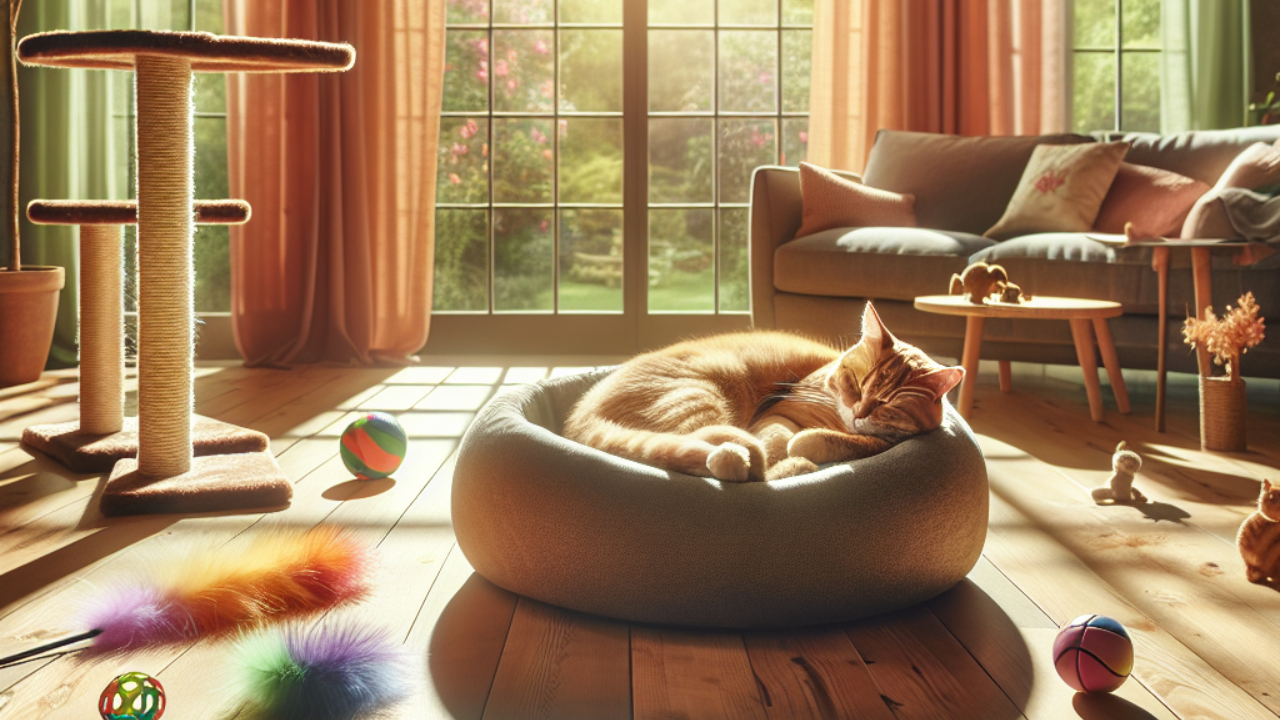
Providing Enrichment for Cats to Alleviate Anxiety
Key Highlights
- Species inappropriate nutrition plays an important role in all aspects of feline health, including emotional health
- Anxiety in cats can cause emotional distress and lead to medical problems such as urinary tract issues.
- Symptoms of anxiety in cats include excessive grooming, urinating outside of the litter box, aggression, hiding, trembling, and decreased appetite.
- Common causes of anxiety in cats include changes in the environment, lack of consistent routine, illness, lack of safe spaces, and improper socialization.
- Treating and managing cat anxiety requires a multi-modal approach that includes behavioral modification techniques, changes to the cat's environment, natural calming aids, and in severe cases anti-anxiety medication.
- Creating a safe place for cats, ensuring easy access to essential resources, providing opportunities for play and predatory behavior, and maintaining positive human interaction are important pillars of feline emotional health.
- Identifying behavior problems in cats and understanding the link between emotional health and behavior are crucial for effectively managing cat anxiety.
Introduction
Anxiety is a very real problem that can not only cause our cats severe emotional distress but can also exacerbate or cause a number of medical problems. It's important for cat owners to understand and address their cat's basic emotional needs in order to improve their overall well-being and quality of life. In this blog, we will discuss the signs of anxiety and ways to create a healthy environment to minimize anxiety. The pillars of emotional health set forth by the AAFP will be highlighted with tips for creating a healthy environment. We will also discuss practical steps that cat owners can take to provide enrichment for their cats and alleviate anxiety. By implementing these strategies, cat owners can help their feline companions live happier, more content lives.

Understanding Feline Emotional Health
Feline emotional health plays a crucial role in a cat's overall well-being. Cats, like humans, can experience stress and isolation. Their emotional health impacts their daily life, including their behavior, appetite, and interactions with their environment and other animals. It's important for cat owners to prioritize their cat's emotional health and take proactive steps to create a positive and enriching environment.
The Impact of Stress and Anxiety on Cats
Stress and anxiety can have a profound impact on cats. Anxiety symptoms in cats can include excessive grooming, urinating outside of the litter box, aggression, hiding, trembling, and decreased appetite. Cats experiencing chronic stress and anxiety are more likely to develop anxiety disorders, which can significantly affect their overall well-being.
High stress levels can also lead to physical health problems. A good example of a stress induced condition in cats is sterile cystitis or "pandora syndrome" in cats. This sterile cystitis (i.e. not caused by bacteria or crystals) is the most common urinary tract problem in young cats. After testing rules out a bacterial infection or crystals/stones, one is left with no medical cause for the condition. Thus the diagnosis of pandora syndrome after "Pandora's Box", where the various stressors in a household lead to difficulty urinating, increased frequency of urination, blood in the urine, and urinating outside the box.

Common Signs of Stress and Anxiety in Cats
Stress and anxiety can manifest in various ways in cats. It's important for cat owners to recognize the signs and symptoms of stress and anxiety in their feline companions. Common signs include:
- Excessive grooming, leading to hair loss.
- Urinating outside of the litter box.
- Aggression or territorial behavior.
- Hiding or trying to escape.
- Trembling, pacing, or restlessness.
- Decreased appetite or increased vocalization.
- If you notice any of these signs in your cat, it's essential to address their stress and anxiety levels. By providing a calm and enriching environment, offering reassurance, and seeking professional help if needed, you can help alleviate their symptoms and promote emotional well-being.
The Five Pillars of Emotional Health for Cats
There are many "pillars of wellness" for humans, and the American Academy of Feline Practitioners have developed one for emotional wellness.
These pillars promote emotional health in cats. I would add Nutrition as the foundation for the pillars. These pillars include providing a safe place for cats, ensuring easy access to essential resources, offering opportunities for play and predatory behavior, emphasizing human interaction, and respecting the feline sense of smell. By incorporating these pillars into their cat's daily life, cat owners can create a supportive and enriching environment that promotes emotional well-being. These pillars draw upon concepts from cognitive behavioral therapy, recognizing the therapeutic value of cats as therapy animals and emotional support animals.

The gut-brain connection in our feline friends is a fascinating subject that deserves our attention. After over 32 years of veterinary practice and a lifetime of cats, I've personally seen the profound impact that diet can have on a cat's behavior and health. A healthy gut can lead to a happier and more relaxed pet, while an unhealthy one can contribute to stress, anxiety, and behavioral issues. This is because the gut and brain are in constant communication through the gut-brain axis, a bidirectional communication pathway that can influence mood and behavior. The quality ingredients found in Holistic Vet Blend products can support this connection, promoting a healthier gut and thus a happier cat. Don't just take my word for it though, we have countless testimonials from satisfied customers who have seen a positive change in their cats after switching to our products.
Providing a Safe Place for Cats

Creating a safe place for cats is essential for their emotional well-being. Cats need a space where they can retreat to when they feel overwhelmed or anxious. This safe place provides them with a sense of security and helps alleviate feelings of loneliness. Consider the following tips for providing a safe place for your cat:
- Set up a designated area in your home where your cat feels safe and comfortable, away from other pets and children that may be fearful of.
- Provide hiding spots such as cat trees, cardboard boxes, or cozy beds.
- Ensure there are no loud noises or sudden disturbances in the area
- Create a routine that includes daily playtime and interaction with your cat.
- Avoid suddenly overwhelming your cat with too many children, visitors or unfamiliar animals. Ease them into these situations.
- By offering a safe place for your cat, you can help reduce their anxiety and provide them with a sense of security in their daily life.
Ensuring Easy Access to Essential Resources for Cats

To promote emotional health in cats, it's important to ensure easy access to essential resources. Cats rely on certain resources for their daily life and well-being. These resources include:
- food: cats prefer to eat in solitary away from other cats in the household
- water: multiple water sources in the environment
- litter boxes: there should be one box per cat plus one, boxes in a quiet area
- safe spaces: cat trees, window seats, hiding spots, resting spaces
- scratching posts: upright, s shaped, vs. flat scratchers, offer a variety of scratching surfaces, they should be sturdy and not move when scratching
By ensuring that your cat has easy access to these resources, you can help reduce stress and anxiety. A simple hack for a senior cat to get in and out of a box is to take an under the bed clothing container and covert it into a litter box by cutting out an area for them to easily step in and out. Kittens prefer S shaped scratching surfaces. Seniors prefer carpet scratchers. Place scratchers near resting areas as the first things cats like to do when waking up is to stretch and scratch. Place scratching surfaces near household items you prefer they not scratch. Place catnip on the scratcher to entice them.
Opportunities for Play and Predatory Behavior

Play and predatory behavior are essential for a cat's emotional well-being. Engaging in play provides physical and mental stimulation and helps alleviate stress and anxiety. Consider the following tips for providing opportunities for play and predatory behavior for your cat:
- Set aside 15 minutes for play or grooming twice a day
- Offer a variety of toys that simulate hunting, such as interactive puzzle toys or feather wands.
- Set aside dedicated playtime each day to engage with your cat.
- Create an enriching environment with vertical spaces for climbing and exploring.
- Provide scratching posts and toys that allow your cat to engage in natural predatory behaviors.
- By incorporating play and predatory behavior into your cat's daily routine, you can help reduce stress levels and promote emotional well-being.
The Role of Human Interaction in Feline Emotional Health
Human interaction plays a vital role in a cat's emotional health. Cats are social animals and thrive on companionship. Regular interaction with their pet parents provides a sense of comfort and security. Spending quality time with your cat, such as petting, grooming, and playing, can strengthen the bond between you and your feline companion. Talking to your cat and providing gentle reassurance can also contribute to their emotional well-being. By prioritizing human interaction and being a loving and attentive pet parent, you can help alleviate anxiety and promote a positive emotional state in your cat.
Respecting the Feline Sense of Smell

The feline sense of smell is highly developed and plays an important role in their emotional well-being. Cats rely on scent to communicate with their environment and other animals. Respecting their sense of smell can promote a sense of security and relaxation. Consider the following tips for respecting the feline sense of smell:
- Avoid using strong-smelling cleaning products or scents that may be overwhelming for your cat.
- Provide scent enrichment with catnip or pheromone sprays that can help calm and relax your cat.
- Create a calm and soothing environment by using natural scents, such as lavender or chamomile.
- Allow your cat to explore and investigate new scents in a safe and controlled manner.
- By respecting your cat's sense of smell, you can create a peaceful and comforting environment that promotes emotional well-being.
Identifying Behavior Problems in Cats
Behavior problems can be an indication of underlying mental health issues in cats. These problems can manifest as aggression, excessive grooming, urinating outside of the litter box, or hiding. Identifying and addressing these behavior problems is crucial for improving a cat's mental health and overall well-being. In some cases, cats can even become therapy animals, providing emotional support and companionship to their owners. By recognizing and addressing behavior problems, cat owners can help their furry companions lead happier and more fulfilling lives.
Understanding the Link Between Emotional Health and Behavior in Cats
There is a strong link between emotional health and behavior in cats. Emotional health issues can often manifest as behavior problems. Understanding this link is crucial for effectively managing and treating cat anxiety. By addressing the root causes of emotional health issues, cat owners can help improve their cat's behavior and overall well-being. The following text table provides an overview of the link between emotional health and behavior in cats:
|
Emotional Health Issues |
Behavior Problems |
|
Anxiety |
Urinating outside of the litter box, aggression, excessive grooming |
|
Fear |
Hiding, trying to escape, increased vocalization |
|
Stress |
Trembling, pacing, restlessness |
|
Depression |
Decreased appetite, lethargy |
By recognizing and addressing emotional health issues, cat owners can effectively manage behavior problems and promote a positive emotional state in their feline companions.
Practical Steps to Provide Enrichment for Cats
Providing enrichment for cats is essential for their overall well-being and quality of life. Enrichment activities stimulate their minds, encourage natural behaviors, and alleviate stress and anxiety. By incorporating cognitive behavioral therapy principles into their daily life, cat owners can create a positive and enriching environment for their furry companions. This environment promotes emotional well-being, reduces boredom, and enhances their overall quality of life.

Tips for Creating a Cat-Friendly Environment
Creating a cat-friendly environment is key to providing enrichment for your feline companion. Consider the following tips for creating a cat-friendly environment:
- Provide vertical spaces such as cat trees or shelves for climbing and exploring.
- Offer cozy hiding spots and comfortable resting areas.
- Use interactive toys and puzzle feeders to stimulate their minds.
- Install window perches to allow cats to observe the outside world.
- Play soothing music or use calming pheromone sprays to create a relaxing atmosphere.
- By creating a cat-friendly environment, you can help stimulate your cat's natural behaviors, increase their serotonin levels, and promote relaxation and overall well-being.
Engaging Your Cat in Play and Exercise
Regular play and exercise are essential for a cat's emotional and physical health. Engaging your cat in play not only provides mental stimulation but also helps lower their blood pressure and reduce anxiety. Consider the following tips for engaging your cat in play and exercise:
- Use interactive toys that mimic prey to encourage natural predatory behavior.
- Schedule dedicated playtime each day to keep your cat active and entertained.
- Provide scratching posts, climbing structures, and interactive puzzles to promote exercise.
- Rotate toys regularly to keep your cat engaged and prevent boredom.
- By incorporating play and exercise into your cat's routine, you can help them burn off excess energy, reduce stress levels, and promote a healthy and balanced lifestyle.

Maintaining a Positive Routine with Your Cat
Maintaining a positive routine is crucial for a cat's emotional well-being. Cats thrive on consistency and predictability. Consider the following tips for maintaining a positive routine with your cat:
- Establish a regular schedule for feeding, playtime, and interactive sessions.
- Provide daily mental stimulation through puzzle toys or training exercises.
- Set aside dedicated time for grooming and bonding with your cat.
- Ensure that their litter box is clean and easily accessible.
- Offer plenty of affection and companionship to make them feel loved and secure.
- By maintaining a positive routine, you can provide structure and stability for your cat, reducing anxiety and promoting emotional well-being.
When to Seek Help from a Veterinary Behaviorist
Seeking help from a veterinary behaviorist is important when dealing with severe or chronic anxiety in cats. Veterinary behaviorists are experts in diagnosing and treating behavior issues in animals. They can provide specialized guidance and develop a customized treatment plan for your cat's specific needs. If your cat's anxiety is significantly affecting their quality of life or is accompanied by other medical conditions such as chronic pain or mental health conditions, it's advisable to consult a veterinary behaviorist for professional help.
Role of Veterinary Behaviorists in Managing Cat Behavior Issues
Veterinary behaviorists play a crucial role in managing and treating cat behavior issues. These professionals have undergone specialized training in animal behavior and can offer expert guidance and support. Veterinary behaviorists can help diagnose the underlying causes of behavior issues in cats and develop effective treatment plans. They may recommend behavior modification techniques, environmental changes, or medication when necessary. In severe cases, they can also assist in determining if a cat is suitable to become a therapy cat. By consulting a veterinary behaviorist, cat owners can gain valuable insights and resources to address their cat's behavior issues and improve their emotional well-being.
When Medication May Be Necessary
In some cases, medication may be necessary to manage severe anxiety in cats. Medication can help reduce anxiety levels and make a significant difference in a cat's overall well-being. If behavioral modification techniques, environmental changes, and natural calming aids are not enough to alleviate the cat's anxiety, a veterinarian may prescribe anti-anxiety medication. It's important to work closely with a veterinarian to determine the appropriate medication and dosage for your cat. Medication should always be used in conjunction with other treatment strategies and under the guidance of a professional. By considering medication as part of a comprehensive treatment plan, cat owners can provide their cats with the support they need to overcome severe anxiety and improve their emotional health.

Conclusion
In conclusion, understanding and addressing the emotional well-being of cats is vital for their overall health and behavior. Enriching their environment, providing mental stimulation, and seeking professional help when necessary can significantly enhance their quality of life. As pet parents, recognizing the signs of anxiety and stress in our feline companions and taking proactive measures is essential. By incorporating NLP terms such as mental health, therapy animal, and cognitive behavioral therapy, we can ensure a holistic approach to caring for our beloved feline friends.
Frequently Asked Questions
What are some signs my cat might be experiencing anxiety?
Signs that your cat might be experiencing anxiety include excessive grooming, urinating outside of the litter box, aggression, hiding, trembling, and decreased appetite. If you notice these symptoms, it's important to address your cat's stress levels and seek professional help if needed.
How can I help my cat feel safer at home?
To help your cat feel safer at home, create a safe place where they can retreat when they feel anxious. Provide hiding spots, a quiet and calm environment, and plenty of companionship and reassurance. This will help alleviate feelings of loneliness and improve their overall quality of life.
What kind of play is best for a stressed or anxious cat?
For a stressed or anxious cat, play that encourages natural predatory behavior is best. Use interactive toys that mimic prey, such as feather wands or puzzle toys. This type of play helps reduce stress levels, stimulates serotonin production, and promotes relaxation.











